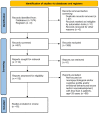Clinical, Cognitive and Neurodevelopmental Profile in Tetrasomies and Pentasomies: A Systematic Review
- PMID: 36360447
- PMCID: PMC9688827
- DOI: 10.3390/children9111719
Clinical, Cognitive and Neurodevelopmental Profile in Tetrasomies and Pentasomies: A Systematic Review
Abstract
Background: Sex chromosome aneuploidies (SCAs) are a group of disorders characterised by an abnormal number of sex chromosomes. Collective prevalence rate of SCAs is estimated to be around 1 in 400-500 live births; sex chromosome trisomies (e.g., XXX, XXY, XYY) are most frequent, while tetra- and pentasomies (e.g., XXXX, XXXXX, XXXY, XXXXY) are rarer, and the most common is 48, XXYY syndrome. The presence of additional X and/or Y chromosomes is believed to cause neurodevelopmental differences, with increased risk for developmental delays, language-based learning disabilities, cognitive impairments, executive dysfunction, and behavioural and psychological disorders. Aim of the Study: Our review has the purpose of analysing the neurocognitive, linguistical and behavioural profile of patients affected by sex chromosomes supernumerary aneuploidies (tetrasomy and pentasomy) to better understand the specific areas of weakness, in order to provide specific rehabilitation therapy. Methods: The literature search was performed by two authors independently. We used MEDLINE, PubMed, and PsycINFO search engines to identify sources of interest, without year or language restrictions. At the end of an accurate selection, 16 articles fulfilled the inclusion and exclusion criteria. Results and Conclusions: International literature has described single aspects of the neuropsychological profile of 48, XXYY and 49, XXXXY patients. In 48, XXYY patients, various degrees of psychosocial/executive functioning issues have been reported and there is an increased frequency of behavioural problems in childhood. Developmental delay and behavioural problems are the most common presenting problems, even if anxiety, depression and oppositional defiant disorder are also reported. They also show generalized difficulties with socialization and communication. Cognitive abilities are lower in measures of verbal IQ than in measures of performance IQ. Visuospatial skills are a relative strength compared to verbal skills. In patients with 49, XXXXY, both intellectual and adaptive functioning skills fall into the disability range, with better non-verbal cognitive performance. Speech and language testing reveals more deficits in expressive language than receptive language and comprehension. Anxiety, thought problems, internalizing and externalizing problems, and deficits in social cognition and communication are reported. Behavioural symptoms lessen from school age to adolescence, with the exception of thought problems and anxiety. Individuals affected by sex chromosome aneuploidies show testosterone deficiency, microorchidism, lack of pubertal progression and infertility. Hormone replacement therapy (HRT) is usually recommended for these patients: different studies have found that testosterone-based HRT benefit a wide range of areas initiated in these disorders, affecting not only neuromotor, cognitive and behavioural profile but also structural anomalies of the brain (i.e., increase of volume of grey temporal lobe matter). In conclusion, further studies are needed to better understand the neuropsychological profile with a complete evaluation, including neurocognitive and psychosocial aspects and to establish the real impact of HRT on improving the cognitive and behavioural profile of these patients.
Keywords: developmental disorders; neurocognitive profile; neuropsychological profile; sex chromosome aneuploidie (SCAs); sex chromosome pentasomy; sex chromosome tetrasomy.
Conflict of interest statement
The authors declare no conflict of interest.
References
-
- Thompson T., Howell S., Davis S., Wilson R., Janusz J., Boada R., Pyle L., Tartaglia N. Current survey of early childhood intervention services in infants and young children with sex chromosome aneuploidies. Am. J. Med. Genet. Part C Semin. Med. Genet. 2020;184:414–427. doi: 10.1002/ajmg.c.31785. - DOI - PMC - PubMed
-
- Lee N.R., Wallace G.L., Adeyemi E.I., Lopez K.C., Blumenthal J.D., Clasen L.S., Giedd J.N. Dosage effects of X and Y chromosomes on language and social functioning in children with supernumerary sex chromosome aneuploidies: Implications for idiopathic language impairment and autism spectrum disorders. J. Child Psychol. Psychiatry. 2012;53:1072–1081. doi: 10.1111/j.1469-7610.2012.02573.x. - DOI - PMC - PubMed
-
- Dulac O., Lassonde M., Sarnat H.B. Cognitive and Medical Features of Chromosomal Aneuploidy—Handbook of Clinical Neurology. 3rd ed. Volume 111 Elsevier B.V.; Amsterdam, The Netherlands: 2013. Pediatric Neurology Part I.
Publication types
LinkOut - more resources
Full Text Sources


